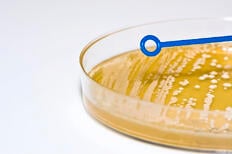 We perform over 100 transformations each week at Addgene, so we need to be cost and time efficient. We do this by making our own competent cells and using a little-known reagent for streamlining the transformation step.
We perform over 100 transformations each week at Addgene, so we need to be cost and time efficient. We do this by making our own competent cells and using a little-known reagent for streamlining the transformation step.
Read on to find protocols and tips that you can use in your own lab.
How to make your own competent cells
It’s easy to make your own competent cells. If you need a high efficiency of transformation (for example, if you are working with a library or an especially low concentration of plasmid), you will benefit from purchasing competent cells. However, for most everyday cloning, homemade competent cells will work just fine.
A number of protocols for making competent cells are available online. A few examples are provided here for reference:
- OpenWetWare
- Untergasser Lab
At Addgene, we use the Mix & Go! E. coli Transformation Kit and Buffer Set from Zymo Research to make competent cells because cells prepared using this kit can be transformed without heat shock. Detailed protocols are available via Zymo Research. In brief, we grow our E. coli in LB to log phase, then wash and resuspend the cells in the provided buffers. The competent cells are then aliquoted and stored at -80oC until we are ready to perform transformations.
A typical 200mL bacterial culture produces 20mL of competent cells, enough for 800 transformations when using 25uL competent cells per reaction. We grow our cells in LB rather than the ZymoBrothTM, so it costs us less than 5 cents per transformation.
This protocol has worked well for us for multiple E. coli strains, including DH5alpha, XL1 Blue, TOP10, ccdB survivalTM, and Stbl3TM.
How to transform your plasmid DNA
If you decided to use commercial competent cells, then you're best off following the instructions that came with them. If you decided to make your own competent cells using the protocols provided above, then you can find the subsequent transformation protocols below:
- Untergasser Lab
Cells prepared using the Z-competent TM buffer can be easily transformed without a heat-shock step. Because of the large number of transformations being performed at Addgene, this adds up to a significant time savings.
You can also save yourself time if you're transforming a plasmid with ampicillin resistance. After a plasmid is introduced to bacteria, the bacteria is typically grown in liquid culture without antibiotics to give the antibiotic resistance gene time to be expressed. However, you can skip this incubation step and go straight to plating if your transformed cells are being plated on agar with ampicillin selection.
Notes and tips
- We’ve found that our competent cells are good for at least a year when stored at -80oC.
- For each new batch of competent cells, don’t forget to do a negative control (plate your cells without adding plasmid) to make sure you don’t have contamination.
- Also conduct a positive control (test a plasmid that transforms well in other competent cells) to ensure that your cells can be readily transformed. Compare the number of colonies obtained using your fresh batch of competent cells with those obtained using commercially available cells or previous batches of homemade competent cells to ensure good efficiency.
Want even more tips for transforming your cells? Check out our transformation guide.






Leave a Comment